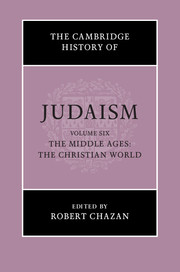Book contents
- The Cambridge History of Judaism
- The Cambridge History of Judaism
- The Cambridge History of Judaism
- Copyright page
- Contents
- Figures
- Introduction
- Part I Jews in the Medieval Christian World
- Part II Social and Institutional History
- Part III Spiritual and Intellectual History
- Suggested Readings
- Index
- References
Suggested Readings
Published online by Cambridge University Press: 01 October 2018
- The Cambridge History of Judaism
- The Cambridge History of Judaism
- The Cambridge History of Judaism
- Copyright page
- Contents
- Figures
- Introduction
- Part I Jews in the Medieval Christian World
- Part II Social and Institutional History
- Part III Spiritual and Intellectual History
- Suggested Readings
- Index
- References
Summary

- Type
- Chapter
- Information
- The Cambridge History of Judaism , pp. 882 - 904Publisher: Cambridge University PressPrint publication year: 2018

